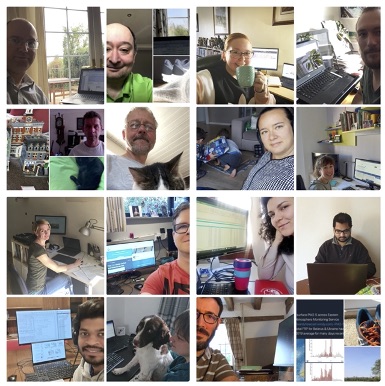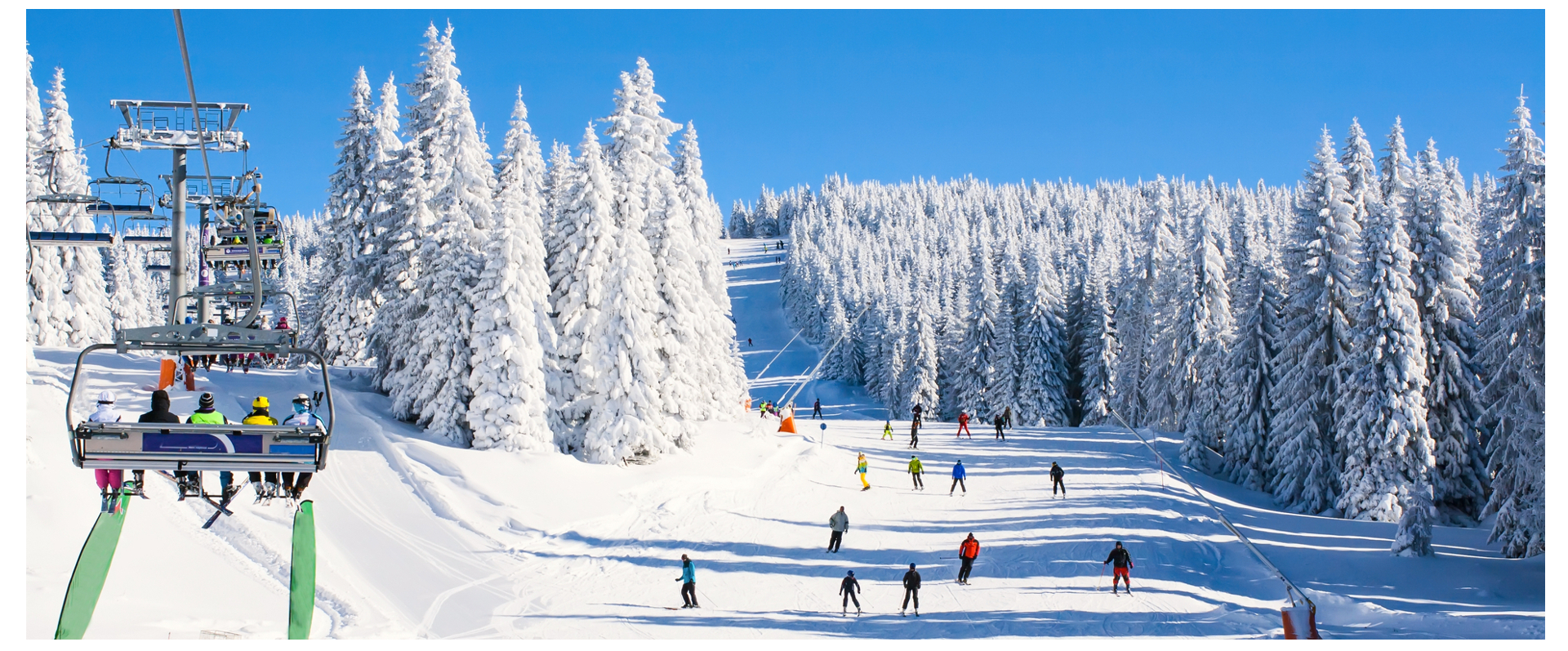|
News and information about EUCP, the research project that develops the foundation for a cutting edge climate prediction system for Europe.
The EUCP project aims to support both scientists and climate information providers to produce better climate information. To do this, EUCP develops innovative approaches on how to use existing climate predictions*, as well as providing new climate simulations. This will enable climate information providers to produce more consistent, authoritative, and actionable climate information in order to better support decision-makers on climate adaptation and mitigation.
*The term “prediction” here refers to both predictions and projections. See here for a detailed explanation on the difference between climate projections and climate prediction.
|
| |
Introduction - Towards more engagement and collaboration | |
|

A snapshot of selfies shared on Twitter from participants to EUCP’s #sciencefromhome challenge that ran from April 6th to April 14th
The EUCP project passed its second birthday in December and the past six months have seen a real surge of activity. It is an exciting time for the project: while we celebrate the new science that has emerged from the individual work packages (WP) in our first couple of years, we are now at a point where we can take the new science to ‘users’ in our multi-user forum and explore new avenues for collaboration across work-packages.
This period was always going to be a busy period for collaboration and face-to-face events, beginning with the project’s third annual General Assembly in Delft in March, a dedicated EUCP session at the European Geosciences Union’s General Assembly (EGU) in Vienna in May, and project workshops to bring some of the key science topics together in June and October. Of course, this year has brought many new challenges and all of our partners are having to adjust to our new working world of remote collaboration. The impact of COVID-19 became very real to the EUCP project in early March when our planned General Assembly in Delft had to be rapidly moved to Zoom. We have since also run a very successful EGU session remotely, and are rapidly moving project meetings and workshops online.
As our partners across Europe continue to work on EUCP from our diverse new ‘offices’, many colleagues from EUCP and beyond joined our #sciencefromhome Twitter challenge to share selfies in our new working environments (and some of our new ‘office mates)!
Disruption to normality makes some activities harder to run, and so we decided to postpone our workshop on bringing together global climate projections and decadal predictions for Europe, originally planned in June. Instead, we held shorter and internal virtual sessions to keep the momentum going. Despite this, the project continues to move forward with many interesting activities lined up for summer 2020. For example, we are looking forward to finalising our plans for new convection permitting simulations for three new domains. This will provide new understanding of potential climate variability and change for some of the EU’s outermost regions, including the Caribbean.
Find out more about some of these activities below!
|
| |
EUCP General Assembly 2020 – a successful remote gathering! | |
|
Some of the EUCP Coordination team at the Met Office, Exter, UK, tuning into the remote General Assembly on Zoom on March 10th 2020.
Our annual meeting, originally planned in Delft, Netherlands, was hosted online successfully between the 10th and 12th of March: more than 60 EUCP colleagues gathered on Zoom across 2 days of presentations and discussions. These two days highlighted recent progress in our science, including results from the new multi-model kilometre scale resolution climate projections for Europe and climate impact studies (More on the progress presented here). Discussions also focused on next steps and enabled progress on the project’s core objectives such as the merging of climate predictions for the next 1-10 years with longer-term climate projections (10-100 years) (more on key topics here).
While we missed face-to-face discussions, debates and socialising, we found some real advantages of the remote-meeting format. As well as reducing our carbon emissions, the remote format allowed some of our colleagues to join who would not have been able to travel to a face-to-face meeting. We learned a lot about how effective remote meetings can be, and we hope that future EUCP meetings will be able to make the ‘best of both worlds’ by combining face-to-face and remote participation.
|
| |
Engaging users:
Consultations with members of the Multi-User Forum | |
|
 One of the main goals of the engagement approach in the European Climate Prediction (EUCP) project is to reduce the gap between ‘top-down’ climate information driven by science and ‘bottom-up’ end-user requirements in order to increase the credibility and usability of climate information. This is a major barrier to the use of climate information in decision making at present. One of the main goals of the engagement approach in the European Climate Prediction (EUCP) project is to reduce the gap between ‘top-down’ climate information driven by science and ‘bottom-up’ end-user requirements in order to increase the credibility and usability of climate information. This is a major barrier to the use of climate information in decision making at present.
EUCP has been holding a series of consultations with specifically chosen users to delve into this issue and to better understand what successfully using climate information looks like. Seven users of climate information took part, including national and international organisations and programmes, industry and private consultancies. These users range from meteorological and climate service providers, to manufacturers, and institutes and consultancies specialised in natural resource management.
These consultations were done to guide the shaping of future climate information that EUCP may produce, and to ensure this information would fulfil the needs of multiple users from a multitude of sectors. Some of the consultations’ findings include which areas users are interested in (Europe and beyond), which climate information time scales are used (from day-to-day forecasts via seasonal forecasts and decadal predictions to longer term climate projections) and other needs relating to climate information (for example, increased predictability and confidence of short-term (1-10 years) climate information).
|
| |
Event highlight:
Our European Geosciences Union-related session | |
|
 On the occasion of this year’s European Geosciences Union (EGU) General Assembly, EUCP hosted a session on “Bringing together future climate predictions and projections for Europe”, focused on a central objective of our project: making better use of climate predictions and projections on time-scales from a season to several decades. This will help combine all the different and sometimes confusing sources of climate information. The EGU-related EUCP session invited contributions from within and outside the EUCP community to discuss progress and show results of recent research on this matter. On the occasion of this year’s European Geosciences Union (EGU) General Assembly, EUCP hosted a session on “Bringing together future climate predictions and projections for Europe”, focused on a central objective of our project: making better use of climate predictions and projections on time-scales from a season to several decades. This will help combine all the different and sometimes confusing sources of climate information. The EGU-related EUCP session invited contributions from within and outside the EUCP community to discuss progress and show results of recent research on this matter.
|
| |
Research highlight: What does the future hold for climate-vulnerable industries? | |
|
 We are all aware of the challenges climate change poses to society and we are surely aware that some sectors are likely to be impacted more strongly by climate change than others. But what about industries that rely on cold weather and wintery conditions? Is their outlook in our warming world as bleak as it would seem? We are all aware of the challenges climate change poses to society and we are surely aware that some sectors are likely to be impacted more strongly by climate change than others. But what about industries that rely on cold weather and wintery conditions? Is their outlook in our warming world as bleak as it would seem?
This was explored in EUCP-supported research from a team led by Pierre Spandre of the Université Grenoble Alpes. The researchers used an innovative method to assess snow reliability at ski resorts in the Pyrenees and French Alps, using a specialised physical model of the snowpack, along with detailed meteorological data and global climate models.
By the middle of the century the snow reliability of ski resorts is projected to have fallen in both the Alps and the Pyrenees, with the elevation of reliable snow often increasing significantly. However, the projected reduction in reliability is small enough to be countered by increased snowmaking (that is if enough water is available).
The outlook beyond 2050 depends on how much warming occurs. Low warming could see ski resorts in a better position by 2100 than in 2050, however high warming would bring significant challenges. A ‘high’ emissions scenario could see no ski resorts remaining naturally reliable by 2100 in the Pyrenees or French Alps, with only 24 of the 175 ski resorts in these areas able to remain open with artificial snowmaking, all of them in the Alps.
These findings make clear the problems facing the skiing industry in the future, helping inform the industry in its policies and investment.
|
| |
|
This study, from a team led by Danijel Belušić of the Swedish Meteorological and Hydrological Institute, presents a new version of a regional climate modelling system called HCLIM. HCLIM uses atmospheric physics packages from three different numerical weather prediction models, allowing it to operate at a variety of different spatial resolutions. The project’s focus is on convection-permitting modelling, high-resolution modelling able to accurately simulate relatively small-scale processes such as atmospheric convection. This new version of the collaboratively produced HCLIM model presents many improvements over its predecessors, including the ability to work in different conditions without additional region-specific tuning. The model is able to make more accurate predictions than ever before, providing confidence in the model’s predictions and helping their use by people and policymakers.
|
| |
|
This paper from a team led by Julien Boé of the Université de Toulouse, France, assesses the differences between predictions made by regional and global climate models. The regional model they studied projected a European climate in 2100 that was 1.5-2°C colder than in the global model, and with a much smaller projected decrease in precipitation. The regional model’s projection also differed from that of the global model in other values such as cloud cover, evapotranspiration and relative humidity. Overall, the team conclude that their regional model may not capture the upper bounds of possible future climate scenarios, which has important implications for how these projections are used in policy decisions. The caveats associated with models like this mean we must be cautious about the conclusions we draw from these results, however the team urges those carrying out climate change impact studies to include results from global models and not rely too much on regional ones.
|
| |
|
This study led by Jesús Vergara-Temprado of ETH Zürich looks at how climate models handle atmospheric convection at different spatial scales. Low-resolution models, working with a 50 km grid spacing, performed better when convection was parameterised, or assumed using existing values. At higher resolutions of 25 km and below the models produced better simulations when this parameter was removed, allowing the model to explicitly simulate convection by itself. Such ‘convection-permitting’ models have been used for high-resolution applications such as weather forecasting for many years, but this study shows that these models can perform well at much lower resolutions than previously thought. This allows these models to be used with much less computational cost, potentially expanding their usefulness. Very high resolution models were found to still be best able to simulate some factors, such as radiative fluxes at the top of the atmosphere, but these new findings are very important for how we use climate models going forward.
|
| |
|
Current restrictions due to the COVID19 pandemic have impacted the following events:
● The EUCP workshop on global climate projections and decadal predictions for Europe has been postponed until further notice. The workshop was initially scheduled between Tuesday 23rd and Thursday 25th June 2020 at the Physics Department of the University of Oxford in the UK. An internal online event has been held instead to keep momentum going, and we are hoping to host the workshop in the future once conditions allow for it.
● The 2020 Climateurope Festival will be held as a series of virtual events, or ‘webstivals’. These started on the 18th of June and will continue over the course of summer and autumn 2020. On the topic ‘Climate information at your service’, these events aim at creating an environment to support climate services by bringing together a range of people including climate service users, providers and funders, to share their experiences and knowledge. This continues the dialogue between science and society that was started in previous years at festivals in Valencia and Belgrade. Each webstival will be a virtual meeting lasting 3-4 hours on a single day and is open to researchers, suppliers and users of climate information, as well as funders from all over Europe and beyond.
EUCP will take advantage of the webstivals to start conversations with users of climate information who will be attending. These conversations will help EUCP better understand specific organisations’ sensitivities to future weather and climate and their potential needs for climate information. Talking to the webstival attendees will enable us to hear opinions from businesses and policy makers we would not ordinarily engage with. To read more about the webstivals, click here.
|
| |
European Climate Prediction system: producing actionable climate information for risk-based planning
https://www.eucp-project.eu/
https://www.eucp-project.eu/privacy-policy-statement/
|
|
|
|